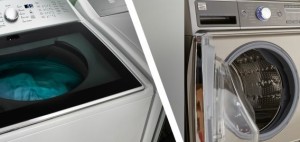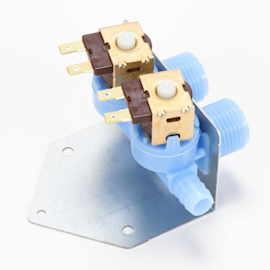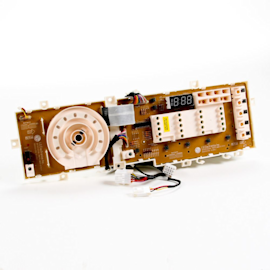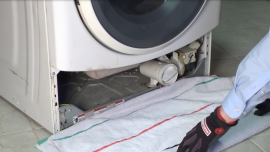Should I get a top-load or front-load washer? -- A fresh new look at this topic


When buying a new washer, you’ll be faced with this important decision—top-load or front-load.
For many years since the turn of the century, many buyers chose front-load washers over top-loaders. That trend has changed in recent years. Now, top-load washers are just as popular and front-loaders.
Both types of washers have advantages and drawbacks. Choosing the type of washing machine that’s right for you depends on your personal preferences and needs.
How to choose between a top-loader and front-loader
When you want a deep-fill washing machine, the choice is simple--you’ll definitely need a top-loader. You can buy a deep-fill, top-load washer with an agitator but you won’t find any deep-fill front-loaders.
When deciding between HE (high-efficiency) top-load and front-load washers that both use shallow water fills, consider these pros and cons of each washer type.
Top-loaders Pros
1. Price
Base models of deep-fill top-load washing machines cost hundreds less than HE models of front-load and top-load washers. Nowadays, HE Top-load washing machines typically cost about the same as a front-load washer with the same capacity and comparable features. Also, base models of HE top-loaders typically cost about the same as front-loader base models.
If you use a stacking kit or add a pedestal under your front-load washer, you will likely pay hundreds more for a front-loader than an HE top-loader.
In some situations, the price of a top-loader can be a significant advantage over a front-load washer.
2. Ease of unloading
For some people, especially those with back problems, it’s much more comfortable to unload clothes from the top of the washer. No bending required.
If you add a pedestal below your front-loader to raise its height, this advantage disappears but the price advantage kicks in.
3. Shorter wash times
Although many front-load washers have a quick-wash cycle that only takes about a half hour to complete, most other cycles on front-loaders take 30 to 60 minutes longer than comparable cycles on a top-load washer. The quickest cycle on a top-load washer will typically clean your laundry better than the quick-wash cycle on a front loader because clothes get wetter in the vertical tub of the top loader.
Top-loaders Cons
1. Spacing
When you have a small laundry room or you need to stack the washer and dryer inside a laundry closet, a top-load washing machine may be out of the question when you’re shopping for a new washer. You won’t be able to stack a dryer above a top-load washer.
2. Access
Family members who are shorter in height may have a difficult time reaching the bottom of a top-load washer’s spin basket to remove clothes.
Front-loaders Pros
1. Stacking
A front-load washer is the natural choice when you have limited laundry space and you need to stack the dryer on top of the washer.
2. Drying
Although HE top-loaders now feature high spin speeds, front-load washing machines often spin the water out of clothes better. Because clothes come out of a front-loader drier, they’ll need to spend less time in the dryer. You can save time and money when choosing a front-loader that spins out water from clothes better than a top-load washer.
Front-loaders Cons
1. Mold
Unless cleaned and maintained regularly, front-loaders often develop a rather unpleasant smell because water gets trapped in the seals around the door and mold develops. Mold and mildew also invade the drain pump and the wash tub when you don’t use HE detergent or you use too much detergent. There are ways to prevent mold, mildew and musty smells from happening in a front-loader, but as a buyer, you should consider this issue when deciding on the type of washer that’s best for you. Bad smell has become the #1 reason why consumers shy away from front-load washers.
Of course, if you choose a front-load washer and you want professional help keeping it clean and odor-free, schedule a Sears Technician to perform an annual Clean & Maintain Service on the washer. That type of professional yearly maintenance won’t just keep odor away, it will help your washer last longer and prevent unexpected breakdowns.
2. Instability
Although front-loaders and top-loaders can shake and vibrate, the horizontal axis of front-load washers inherently leads to slightly more instability in some models. It’s often difficult for a front-loader to balance and stabilize certain types of loads like comforters. The extra time that a front-load washing machine takes to balance a load sometimes leads to longer cycle times.
A current approach to making the decision between a front-loader and top-loader
Unless you’re stacking the washer and dryer or you want a deep-fill washer, the choice between front-loaders and top-loaders has become much less significant. The HE versions of these types of washer aren’t much different in terms of performance, energy-use and convenience unless you have specific needs covered in the pros and cons above.
If you’re looking for an HE washer and laundry room space isn’t an issue, the choice often boils down to whether you’re willing to do what it takes to prevent mold and mildew from forming inside a front-load washer. If you like a front-load model and you’re willing to keep it clean, that choice is right for you.
There’s a big reason why consumers are flocking away from buying front-loaders—it’s the moldy smell. If you’re not willing to make the cleaning commitment to avoid mold (or to have your washer professionally maintained yearly), then you should choose a top-load washer.
Keep in mind that if you choose a top-load washer, it’s still a good idea to have it professionally maintained every year to help extend its useful life and avoid unexpected breakdowns as well.
Now, go and choose the type of washer that’s right for you based on this current approach.
Symptoms for front-load washers
Main causes: bad door lock assembly, wiring failure, bad electronic control board, drain system failure, bad water-level…
Main causes: leaky water supply hoses, clogged drain system, torn door boot, cracked outer tub, overfilling…
Main causes: garments left in the washer, damaged spin basket, worn outer tub bearing, faulty drive motor, bad electroni…
Repair guides for front-load washers

How to replace a water inlet valve on a front-load washer
The water valve assembly is the gatekeeper for water entering your front-load washer. You can replace it yourself, follo…

How to replace a motor control board on a front-load washer
The motor control board makes sure the motor spins in the right direction and at the right speed. You can install a new …

How to replace the user interface board in a front-load washer
Follow these steps to replace the user interface board in your front-load washer if the buttons or lights are broken.…
Articles and videos for front-load washers

Find tips for using your washing machine efficiently to save energy and help reduce utility bills.…

Learn about all the convenient features on our Sears PartsDirect website that make your parts purchases easier.…

See how to access and clean the drain pump filter on a front-load washer without an access door.…